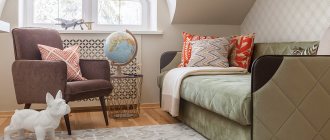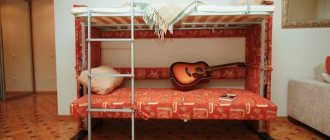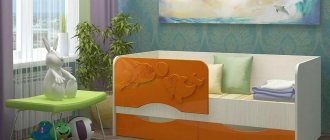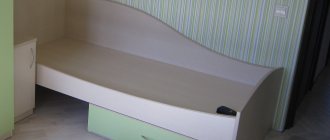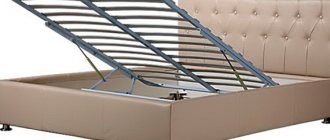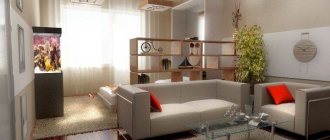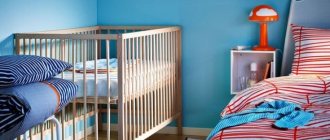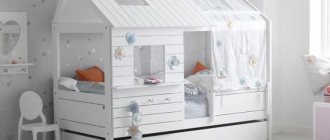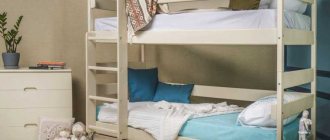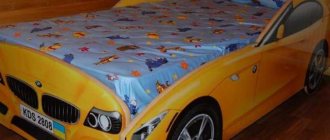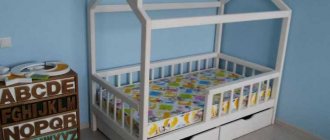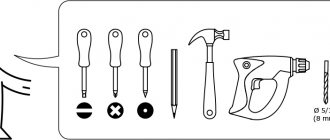Advantages and disadvantages of the model
A sliding bed is a structure consisting of several blocks, which, after transformation, increase the size of the product.
This model has a number of advantages:
- Space saving - even folded double beds take up little free space in the room.
- Comfortable operation - the berth can be pulled out using roll-out rollers. Even a child can do this.
- Functionality - pull-out models are often equipped with niches and drawers that can be filled with linen, toys or seasonal clothing.
- Safety – low height, the sides will protect the baby while sleeping.
- Environmentally friendly - only materials that are safe for children’s health are used to make beds.
- Strength – ensured by the use of innovative mechanisms and modern production technologies.
- Versatility - expandable children's beds are suitable for children of different ages.
- Variety of design solutions.
- Long service life of the bed, thanks to a system that allows the bed to “grow” with the child.
Takes up little space in the room
Functionality
Environmental friendliness
Roll-out rollers
Variety of design solutions
However, along with the advantages, such designs have several disadvantages:
- The pull-out part of the bed may scratch the floor covering. A bedside rug will help solve the problem.
- If the design involves two sleeping places of different heights, the child sleeping on top will have to carefully go down and up so as not to touch the one sleeping below.
- Equipping many structures with plywood bottoms. This material promotes the accumulation of moisture and does not allow air to pass through. Since babies do not yet know how to fully control their nighttime needs, “accidents” cannot be ruled out. To prevent the absorption of moisture and unpleasant odors, it is better to choose models with a slatted base.
- During active children's games, the bed mechanism may be damaged.
There are not many disadvantages to this design. Each type of bed has its own characteristics, which can be regarded as minor disadvantages or advantages: dimensions, shape, method of sliding.
Plywood bottom
The pull-out part may scratch the floor covering
Two berths of different heights
Types of beds
Depending on the age of the child, a bed of a certain size and shape is selected. For kids, compact classic models with additional elements (for example, a chest of drawers) are relevant. Older children will like multi-colored beds with unusual design of sides (carvings, decorative elements). Transformable children's beds can take on different shapes and change their functionality:
- An extendable baby cot with sides around the entire perimeter is suitable for children from 0 to 10 years. The retractable part is located at the feet. Boards on all sides are a necessary safety measure. As they grow older, they can be dismantled. The initial size of a sliding bed for children is 60 x 120 cm. After transformation, the dimensions can increase to 70 x 140 cm or 70 x 160 cm. Such models can be equipped with additional elements: small chests of drawers, drawers for storing toys, a changing table.
- One of the universal options is a grow-out bed for a child from 3 to 12 years old. It consists of two parts. The moving part is located at the feet. Models for children of this age are 80–90 cm wide. The initial length is 120 cm, and the maximum length is 180 cm. For easy storage of bed linen, the model is equipped with a drawer.
- There is also a bed for two children, but it would be more correct to call it a roll-out bed. Outwardly, it resembles a low loft bed. The second berth is located under the top one and can be pulled out either from the front side or from the side. This model may have a third tier, but it will be very low. Drawers are often located under the lower berth. Such a sliding bed for two can be equipped with a special automatic mechanism that allows you to adjust the height of the lower berth.
- A children's extendable sofa allows you to decorate a room beautifully and functionally. During the daytime, it takes up minimal space, and can be folded out before going to bed. When folded, the sofa is suitable for sleeping a baby up to 3 years old, but for an older child it should be extended. These models use a sliding mechanism to increase the length of the bed. Sofas for children are pulled out from the side sides, and the pillows that act as a backrest are placed on the extended parts of the frame and become part of the mattress.
It is not recommended to use a children's sofa as a sleeping place for children under 12 years of age to avoid problems with the spine.
The dimensions of the bed should be matched to the area of the room and the age of the child . If necessary, furniture is made to order so that the sleeping area fits neatly into the available free space.
For sliding sofas and beds, various types of transformation mechanisms are used: book, euro-book, accordion, cascade. The book is considered the most reliable option: in it the base rises and the back reclines. Euro-book is an improved version using springs for transformation. In the accordion mechanism, the backrest is laid flat, forming a long berth. The cascade assumes that part of the berth is located under the main platform and is pulled out if necessary.
Baby cot with sides
Extensible sofa
Children's bed-grow-up
Roll-out bed
Types of beds
Classic options are an island bed and a bed with drawers.
Island beds are versatile; they give a greater degree of freedom when arranging furniture in the room. An island bed looks great either against the wall or in the center of the room. If you and your child love a refreshing change, then an island bed is the perfect solution. In the assortment of the 38 Parrots factory, island beds are represented by such models as an island bed from the Classic collection and a bed with a carriage tie “Classic”.
A bed with drawers is a very functional choice because the drawers provide valuable additional storage space. Beds with drawers include the “Above the Rainbow” lower bed, the “Regan” bed with a drawer, the “Twist” small universal lower bed, the “Slash” universal bed, and the “Classic” bed.
The loft bed is suitable for a child over 5 years old. Loft beds and upper beds usually delight children - they provide scope for a rich child's imagination and inspire a variety of games. What would a child want to become today - a brave ship captain or a mountain peak conqueror?
Also, loft beds are extremely functional: their lower part can be reserved for a second bed, a workplace, a play corner, or a closet. There are many options!
When planning a bunk bed or loft bed, it is important to choose a convenient ladder or steps. The ladder can be with wooden or metal crossbars, built-in or removable. Steps will provide additional storage space.
Loft beds and top beds include, for example, the “Above the Rainbow” top bed.
Manufacturing materials
High-quality beds for children are made from natural materials. Wood is considered the ideal option for the body. Wooden beds are available in a wide range of colors. Models with a lamella base made of natural wood can withstand weight up to 100 kg and provide comfortable rest without harm to the spine.
Metal is a symbol of reliability and long service life . An extendable metal children's bed with a base made of wooden slats is not only strong, but also meets hygienic requirements, since the metal does not absorb moisture and odors. The main disadvantage is the high risk of injury. Since metal is a hard material, it is rarely used for the production of children's furniture. Therefore, this model is only appropriate for an older child who is not very active.
More affordable products are made from chipboard and MDF. These are budget materials that will not harm the child, but their strength and service life will be less than that of natural analogues.
The sliding mechanism is the element that experiences the greatest load during operation, so it must be made of high-quality metal.
Standard upholstery fabrics are used to make the soft part of the bed. When choosing a model, it is better to give preference to options made from natural wear-resistant materials. It is important that they are easy to clean.
Metal sliding bed
MDF bed
Bed with slats
Beds for two children
A popular design option for sleeping arrangements for two children is a bunk bed. Such beds will optimize space and save space.
Plus, kids usually like them a lot.
Another great option is a matryoshka bed, where the lower bed extends out from under the upper one. These beds are ideal if children are still small or if one of them is afraid of heights. The advantage of a matryoshka bed is its affordable price compared to tall structures.
Matryoshka beds include a bed with an extra bed “Newton Gray”, a lower bed with an extra bed “Classic”, a bed with an extra bed “Newton”.
Safety. Firstly, a children's bed may have sides. The sides can be either stationary or removable. Their task is not so much to stop the baby from falling, but to prevent him.
Secondly, the children's bed must be very stable. Children use their sleeping place not only for sleeping, but also for playing, often very active ones.
And finally, it is very desirable that the bed and other furniture in the nursery have rounded ends. This will protect the child from injury.
The models developed at the factory and presented in the catalog meet all safety and quality standards.
Design and colors
The color of the bed should be in harmony with the interior. A children's bed with a sliding mechanism can be made in any colors. For girls, it is better to choose delicate tones: turquoise, pink, cream, coral. Boys will be more comfortable in a more saturated color scheme: blue, green, light blue. White is considered a universal color for children . It is appropriate for decorating a room where children of different sexes live.
Since children love bright designs, many manufacturers make beds with a colorful combination of sidewalls and main frame. The legs can also be in a contrasting color.
Bright colors should not be irritating, as this negatively affects the child's emotional state.
In shape, these can be classic models or complex designs in the form of cars or carriages. Sofas and headboards can be decorated with decorative elements in the form of the sun and animal faces. It all depends on the preferences of the child and his age. Themed beds are suitable for children under 14-15 years old. Teenagers usually choose classic models or high-tech style. The sides of the bed can be decorated with artistic carvings or scenes from popular cartoons.
Beds for children from 3 to 5 years old
When arranging a sleeping place for a 3-5 year old child, you must remember that the coordination of most children of this age is just developing. This means that it is better to choose a bed with sides that completely or partially cover the entire length of the mattress. Sharp corners should be avoided. It’s worth holding off on buying bunk beds and loft beds for children under 4-5 years old.
Preschoolers grow quickly, so it would be appropriate to take a bed at least a little for growth - for the next 3-4 years.
Criterias of choice
Before choosing a children's sleeping place, you need to decide on the basic requirements for it:
- since the children's body is more susceptible to the environment, furniture should be made from natural materials;
- the paint and varnish materials used for surface treatment should not contain toxic substances;
- the structural elements themselves must be carefully polished;
- Fastenings should be checked for safety and security.
Reliable manufacturing factories strictly comply with all product quality requirements. Therefore, well-known brands are more in demand.
In order not to regret your choice, you need to be critical not only of the quality of the model. It is necessary to take into account all the nuances of using the future bed. When choosing it, it is important to pay attention to the following recommendations:
- It is necessary to take into account the age category of the children for whom the bed is selected. The type of design, size and color design will depend on this.
- It is worth giving preference to models with rounded parts to avoid child injuries.
- It is better to choose the widest rollers with the help of which the transformation occurs. They will not scratch the floor or leave deep dents.
- The retractable part of the structure must be equipped with locks that will not allow it to move independently on the floor.
- You should also pay attention to the quality of the frame. It must be durable.
- It is better to give preference to a bed with a slatted base.
Don't forget: the quality of sleep directly depends on the mattress . Therefore, it is better to select orthopedic models with a moderately rigid design that will reliably support the spine in the correct position.
Children's mattresses can be springless or spring. The first fillers are:
- Coconut coir is used to make the hardest mattresses, ideal for newborn babies.
- Polyurethane foam is a modern classic, an artificial material for creating medium-hard mattresses.
- Latex is characterized by increased elasticity; such models support the spine well.
Spring mattresses are considered unacceptable for a child's bed. Combined models combine several fillers. The most popular combination is latex and coconut coir.
An extendable bed for children is an ergonomic option for children's rooms of various sizes. A variety of colors and a wide range of shapes will allow you to choose a model for any age. The ability to transform and increase the sleeping space extends the life of the furniture.
Polyurethane foam in the mattress
Latex mattress
Mattress with coconut coir
